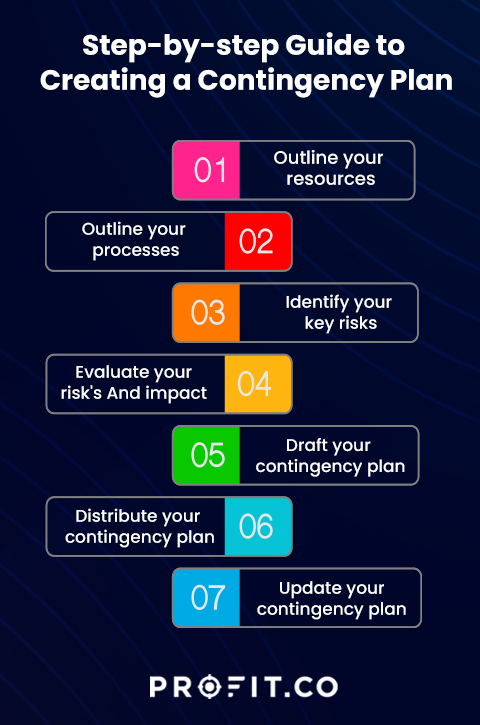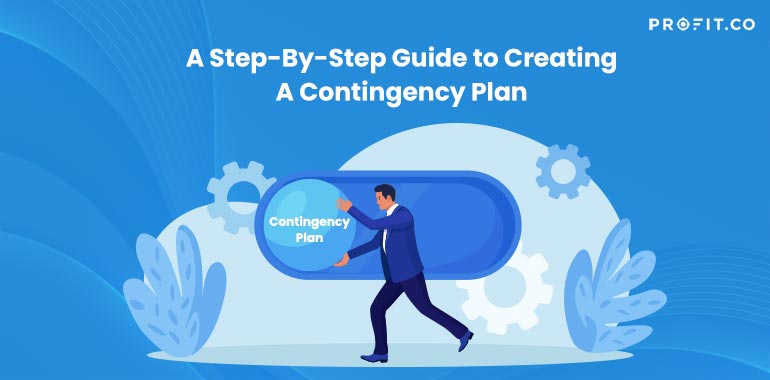Introduction
The best managers prepare for the future, not only for success but for crises. In fact, 95% of business leaders expect a crisis at least once a year. A run of bad luck shouldn’t cripple your business, which is why you need a contingency plan.
What Is Contingency Planning?
A contingency plan is how you deal with worst-case scenarios in your business. In other words, a contingency plan for business outlines your response to risks long before they happen to keep your company going. It can also be a crucial part of strategic planning. It’s a proactive approach to managing risks that disrupt your operations, such as:
- Cybercrime
- Natural disasters
- Leadership
- Acts of sabotage, fraud, or corruption
- Regulatory changes
- Reputation damage
Why Do You Need A Contingency Plan?
A contingency plan is an essential tool that serves a business in the following ways:
- It helps your business react quickly instead of panicking and wasting time.
- It minimizes the damage you’d take by implementing emergency response and recovery.
- It ensures successful project completion since you accommodate disruptions.
- It helps you identify all possible risks to your business in advance.
- It boosts team confidence since you know what to do in a crisis.
When Should You Use A Contingency Plan?
A contingency plan in risk management is an invaluable resource when faced with identified risks. Begin by understanding your business vulnerabilities and plan for them accordingly. However, you can also use a contingency plan to anticipate positive events.
You may receive a funding boost for your projects, hire new talent, or discover an effective digital solution that improves your operations. You can take full advantage of these strategic opportunities using a contingency plan.
To…not prepare is the greatest of crimes; to be prepared beforehand for any contingency is the greatest of virtues.
Contingency Planning
Contingency Planning in Project Management
A contingency plan in project management increases your chances of success. No project goes without unexpected changes, such as team members getting sick, urgent reports, impromptu meetings, power outages, or vendor delays. Identify as many “what if” scenarios for your project as possible and outline the best ways to adapt and overcome them.
If you are looking for software that helps you to execute your team’s daily tasks seamlessly, then Profit.co’s OKR Management software is the perfect solution. You can get started on Profit.co free today!

How To Create A Contingency Plan
Here are the essential steps to ensure a comprehensive contingency plan for any business or project.
- Outline Your Resources
Identify your team members, facilities, and tools you use for your daily operations or the resources required to complete your project. Prioritize these resources from critical to optional to show where to direct your focus during a crisis.
- Outline Your Processes
List down the steps you take to deliver your product to customers from start to finish or the process you’ll undertake to complete your project. For example, if your business is an online store, your process may include the following:
- Ordering stock
- Updating your e-commerce website
- Processing orders
- Delivery or shipping
- Processing returns and refunds
- Identify Your Key Risks
Managers can use tools like S-Curve that handle data, visualize the project’s progress through various stages, identify issues, and find important details hidden in the data. Check each step for vulnerabilities, such as website downtime, delivery delays due to poor weather, damaged packaging during handling, etc. In addition, speak with your team to discover other potential risks you might otherwise overlook. For example, your team members may require a different schedule if they study, have a baby, or care for sick or elderly family members.
- Evaluate Each Risk’s Likelihood And Impact
Let’s say your project’s biggest risk is running out of funds. How likely is that scenario, and how would it affect your business? If there’s a high likelihood that you’ll overrun your budget, revise your project tasks and teams to avoid this outcome.
- Draft Your Contingency Plan
Use a table or spreadsheet to outline the event, expected losses, and the cost of preventing and responding to it. How much revenue would you lose in a data breach? How about hiring a cybersecurity expert or upgrading your systems? Add these costs to your contingency plan.
- Distribute The Contingency Plan
Ensure everyone in your company receives a copy of your contingency plan. Ask for feedback and review the plan. Your contingency plan’s effectiveness relies on your team, so get everyone on board.
- Update Your Contingency Plan
Your business will encounter new opportunities, resources, and industry changes that affect your risk management contingency plan. Revise the plan to show you intend to handle these changes as they arise.
Best Practices in Contingency Planning
Your contingency plan’s details depend on your company’s size, industry, operations, and unique situation. But to ensure your plan is the right fit for your company, here are the best practices to follow:
- Be Inclusive
Get input from every department as you create your contingency plan for business. That’s because a crisis threatens every aspect of your company and needs teamwork to overcome.
- Refine Each Element
A contingency plan prepares you for every possible risk. The better you can capture your vulnerabilities and mitigation tactics, the higher your chances of successfully navigating a crisis. Be realistic about the risks and be ready to adapt to new scenarios throughout your business.
- Conduct Real-World Tests
A contingency plan in risk management remains a theory until it’s tested. Simulate the risks every day and see your contingency plan in action. Assess each tactic for feasibility, improve the agenda, and upskill your team where necessary.
Contingency Planning Template
Numerous examples of contingency plans in business are available online, and you can use the free contingency planning templates. Whichever you choose, ensure your template includes the following:
- Metrics to identify risks in your business, like the project management metrics
- The top 5 high-probability risks or scenarios
- Triggers that activate your contingency plan
- Steps to course-correct and avoid crisis
- A transparent decision-making process from front-line teams to top leadership
FAQs
- What is a contingency plan?
A contingency plan is a strategy that helps a business navigate risk and is created long before a crisis occurs to minimize its impact on operations.
- What is the purpose of a contingency plan?
A contingency plan allows a business to return to normal operations quickly after a crisis, saves resources, and reduces customer inconveniences.
- Are contingency plans only useful for disasters?
Most contingency plans target disaster recovery, but there are examples of contingency plans in business for positive events. You can use a contingency plan to manage a new investor, an R&D breakthrough, or an industry-wide recognition of excellence.
Conclusion
Every company needs a contingency plan because change is a constant part of running a business. Use this guide to create a contingency plan to manage individual projects and your overall operations. This way, you’ll be able to sail through challenges as they come. Book a free demo with our team to learn more about how OKR software can help you from the planning process to seamless execution to optimize your organization’s performance!

